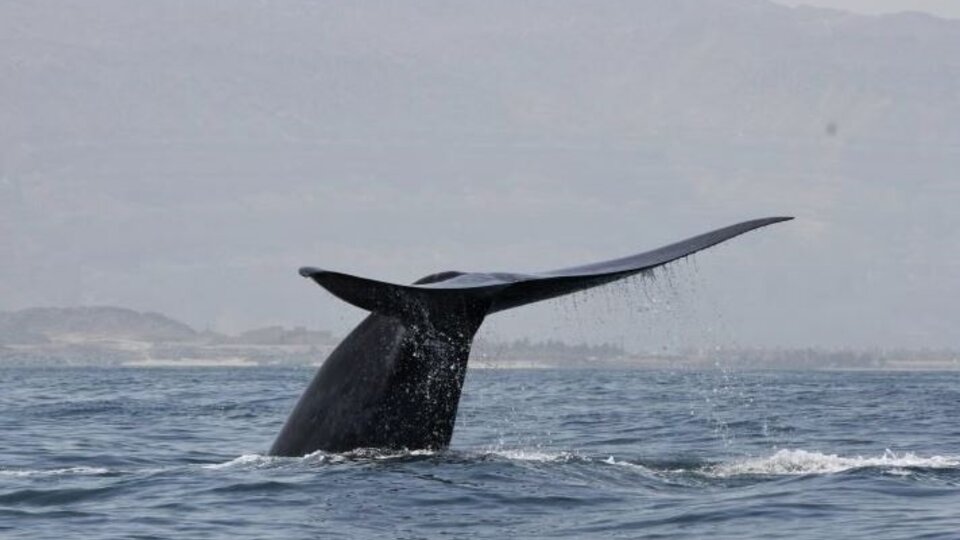
[ad_1]
American scientists have discovered a Unique Blue Whale “Song” heard from the Arabian Sea coast in Oman to the Chagos Archipelago in the central Indian Ocean and as far south as Madagascar in the southwest Indian Ocean. These indications have led experts to believe that there is a new population of this endangered battered species.
Blue whales are the largest animals that have ever lived on the planet and are found in all of the world’s oceans. All blue whales sing very low-pitched and recognizable songs, and for researchers, each population has its own song. The findings were published in an article in the journal Endangered Species Research.
Dr Salvatore Cerchio, director of the cetacean program at the African Aquatic Conservation Fund and visiting researcher at the New England Aquarium, led the analysis of whale records at three locations in the western Indian Ocean.
Cerchio first recorded the novelty song in 2017, during an investigation focused on Omura whales in the Mozambique Channel off Madagascar, and recognized as a blue whale song that had never been described. The expert was working in tandem with a team of scientists collecting acoustic recordings off the coast of Oman in the Arabian Sea.
When analyzing acoustic data from Oman, the team recognized the same unusual song. This new blue whale song was recorded more frequently off Oman than in Madagascar, and it was clear to researchers that they had found what was likely a previously unrecognized blue whale population in the western Indian Ocean.
“It was quite remarkable,” Cerchio said, “to find a whale song in your data that was completely unique, never before reported, and to recognize it as a blue whale.” The song of the blue whale has been studied extensively around the world and various populations of blue whales have been identified on the basis of their distinct songs throughout the Indian Ocean.
“With all this work on blue whale songs, to think that there was a population that no one knew until 2017, well, that leaves you speechless,” Cerchio said.
In 2018, the team reported their findings to the Scientific Committee of the International Whaling Commission (IWC), which was assessing the status of blue whale populations in the Indian Ocean. The discovery generated much excitement at the meeting and raised many new questions about the movements and structure of the blue whale population in the Indian Ocean.
The collaborative team grew and analysis of data from the three sites suggested that the population could spend most of their time in the northwest Indian Ocean, the Arabian Sea and the west of the Chagos.
It has long been recognized that a unique population of blue whales reside in the northern Indian Ocean, but the whales in the Arabian Sea have been assumed to belong to the same population that has been studied off Sri Lanka. and extends into the south-central part of the Indian Ocean. However, the songs tell a different story.
“Prior to our recording effort off Oman, there was no acoustic data from the Arabian Sea, so the identity of this blue whale population was initially only a guess,” said Andrew Willson of Five Oceans Environmental Services LLC, who led the deployment of recording units. “Our work shows that there is much more to learn about these animals, and this is an urgent necessity in light of the wide range of threats to large whales associated with the expansion of maritime industries in the region. “
Driven to the brink of extinction
Blue whales were hunted to extinction around the world during the 20th century, and populations have only started to recover very slowly in recent decades after the global moratorium on commercial whaling .
The Arabian Sea was the target of illegal whaling in the 1960s, an activity that nearly wiped out what were probably already small populations of humpback whales, blue whales, sperm whales and whales. Bryde.
Some researchers consider the blue whales of the northern Indian Ocean and the humpback whales of the Arabian Sea to be unique subspecies, not just populations, which makes them particularly special and important for biodiversity.
.
[ad_2]
Source link
 Naaju Breaking News, Live Updates, Latest Headlines, Viral News, Top Stories, Trending Topics, Videos
Naaju Breaking News, Live Updates, Latest Headlines, Viral News, Top Stories, Trending Topics, Videos